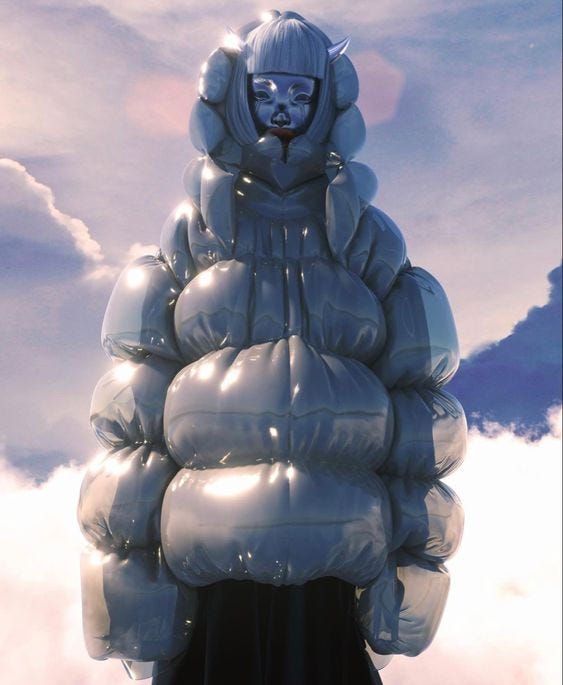"When do digital artifacts overcome their dubious status as mere demonstrations of technical novelty and become artworks worthy or serious consideration?"
— Meredith Anne Hoy, From Point to Pixel: A Genealogy of Digital Aesthetics (2017)
We are up to our eyeballs in shiny puffer jackets.
They’re everywhere in the world of digital fashion. And how strange is that?
Whilst there doesn’t appear to be some great interest in these designs in the physical world, these jackets, with their impossible shine and unpoppable puff, proliferate in every digital showroom.
But why? How did this largely practical piece of outerwear become the reigning trend in what should in theory be a seasonless virtual wardrobe?
To get to the bottom of this craze, we must start by stating the obvious.
Digital puffer jackets aren’t clothes at all. They’re images.
It’s a funny thing to have to point out. But when you’re immersed in a virtual experience, like Fortnite, which crafts an experience of clothing so convincing that players are willing to spend real money (the average Fortnite skins expenditure is close to $50), a little reminder of the virtuality of these outfits is often welcome.
In trying to understand why the internet is overrun by inflatable outerwear, it’s important to approach this trend right off the bat as one not based in real-world fashion-making, but rather in virtual image-making.
In other words, it’s less a trend in what people are wearing (most of these puffers aren’t worn at all, they’re collected) and more a trend in what people are rendering.


Taking a Closer Look
Let's take a closer look at these images.
Frequently exhibited in smooth, slow-motion walking clips, the puffers are displayed in ways that highlight their materiality. But those materials aren’t what one might expect from a jacket.
From chrome, silicon and rubber, to an occasional oil spill — digital depictions of industrial materials are commonplace. Cut into ribs, excessively pumped up with air and then pulled impossibly tight into a jacket, these materials take centre stage.
With nothing obstructing a view of their surfaces, when it comes to digital puffers, it’s not really the jacket we are looking at; it’s the materials rendered in an optimized mode of display. Like a canvas stretched across a wooden frame, the puffer is a showcase—a vessel to flaunt its creator’s skills.
The Subject is Simulation
More show-offs than clothes, these jackets are the best way for creators to display how talented they are at their craft, a craft rooted in simulation more than in design.
From this standpoint, the rise of the digital puffer shares a lot in common with another trend running around the internet: the falling rubber blocks.
Equally categorisable as demonstrations of how well computers can create everyday simulations of physics, these short clips don’t illustrate a whole lot outside of the basic law of gravity.
Yet, they continue to captivate.
How?
Why would a message as banal as “things fall when dropped” illicit so many likes/clicks? Likewise, the response of digital materials to creator-imposed pressurised conditions is not an obvious crowd-pleaser, so why have these images become so popular?
Clearly, there is something going on in the way in which the internet evaluates its 3D images.
Trends in digital fashion are determined by wildly different forces than those at play on the runway. Rather than referring to cut, style or material quality, the puffer jacket trend embodies the new standards and tastes of digital fashion.
A “good” digital puffer jacket presents a material’s response to pressure in such a way that the viewer simply can’t believe it was made by a computer. A “good” digital fashion image can be measured by a viewer’s awe for a computer’s aptitude. A “good” digital fashion image is shockingly not a piece of clothing at all.
Currently, how accurately a garment is technically depicted defines its quality.
Why?
That’s because, still largely unwearable (at least in puffer-piercing resolution), digital-only fashion is currently made to be viewed and not necessarily worn. Standards are defined by image-creators, not fashion designers and judgements are cast by image-viewers, not wearers.
This is not to say that puffer jackets are without design credentials (Moncler’s collaborations with the likes of JW Anderson, Dingyun Zhang and Pierpaolo Piccolo make it very clear that this is not the case). But it is to say that the reason these digital puffers are trending is not due to their design credentials and instead due to our approach to them as digital images.


A Good Digital Puffer Image
In her book From Point to Pixel: A Genealogy of Digital Aesthetics (2017), Meredith Anne Hoy describes our approach to digital images as the glorification of innovation, often cloaked in an ideological mantle. Instead of interpreting digital images for what they are, we view them as “demonstrations of technical novelty.”
Overwhelmed with disbelief for what digital tools can create, the puffer trend shows how the internet has become infatuated with the shiny surfaces of the 3D fashion image. This infatuation skews our judgment. We conflate impressive feats of digital rendering with what’s actually “good” fashion.
The technological prowess of a 3D rendering prevents us from moving deeper into what the digital fashion image actually contains. So what should just be the medium (the digital tool) of an image is read instead as its subject. That means, in the case of digital fashion, we often don’t ever get past the sensational surfaces and into assessing the fashion part—the puffer’s design credentials.
Right now, a trend in digital fashion does not mean a successful design but a successful 3D digital image. The puffer jacket has stolen hearts as a digital image, but could it hold up as a piece of digital clothing?
WRITTEN BY: LAMIA PRIESTLEY









